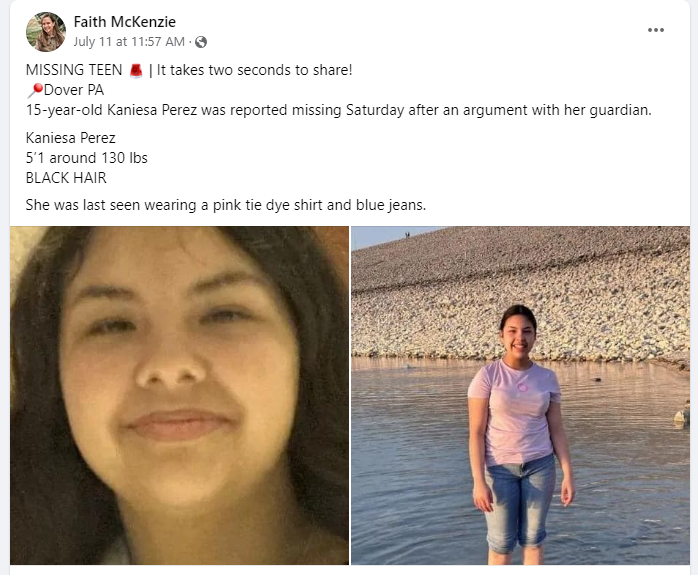

Did authentic social media posts offer genuine concern over a missing teen named Kaniesa Perez? No, that's not true: The posts exploit a real missing teen story and falsely say that Kaniesa Perez went missing on the same day from Dover, Pennsylvania, and Albuquerque, New Mexico, among other locations more than a thousand miles apart. In reality, the teen went missing only from Von Ormy, Texas, on July 6, 2024, and was found safe two days later, the Bexar County Sheriff's Office and multiple local news outlets reported. It's a common scam tactic on social media, to build posts that tug at heart strings that are then switched to commercial messages once they have attracted enough attention through sharing.
One version of the claim appeared in a post on Facebook (archived here) in the group Dover York County Auction on July 11, 2024. It said:
MISSING TEEN| It takes two seconds to share!
Dover PA
15-year-old Kaniesa Perez was reported missing Saturday after an argument with her guardian.Kaniesa Perez5'1 around 130 lbsBLACK HAIRShe was last seen wearing a pink tie dye shirt and blue jeans.
This is what the post looked like on Facebook at the time of writing:
(Source: Facebook screenshot taken on Tue Jul 16 17:58:56 2024 UTC)
Another post claimed she went missing in Albuquerque. The false posts are part of a bait-and-switch ruse that Lead Stories has observed used on Facebook since 2022. The deceptive posts use a variety of stories to entice people to share them, then are later edited to entice people to give up information used in a scam.
Real teen who went missing
The girl named in the post is a real person who did indeed go missing from Von Ormy in July 2024, but was later found safe, San Antonio TV stations KENS 5 and News 4 plus Hoodline reported. While she was missing, the Bexar County, Texas, Sheriff's Office sought public help. A post on Facebook, pictured below, was made by the Bexar County Sheriff's Office on July 7, 2024, and updated on July 8, 2024:
(Source: Facebook screenshot taken on Tue Jul 16 18:56:01 2024 UTC)
Bait-and-switch scam
Another post (archived here) made on July 11, 2024, on the group Albuquerque buy and sale!!!! claimed she went missing in Albuquerque. Here is what the post looked like after it was edited to show a lease-to-own scam:
Title: Lease To OwnPrice: $8903 bedroom, 2 bath house in the area, estimated cost $900 per month. Stove and refrigerator included, Gas heat and trash isincluded in rent.Conveniently located near shopping center and it is in a safe neighbourhood. All pets allowed.Schedule to view the house and see many more optional houses link comment section
(Source: Facebook screenshot taken on Tue Jul 16 18:08:32 2024 UTC)
Below is the edit history of the post, showing the original message regarding a missing teen and then the flip to a commercial pitch:
(Source: Facebook screenshot taken on Tue Jul 16 18:12:46 2024 UTC)
The text was identical to the one claiming the teen went missing in Dover on the same date, July 11, 2024, before the switch. Only the location was changed in the two versions.
A reverse image search shows the house in the real estate post was listed on Trulia.com and Zillow.com. The house is not in Albuquerque, as the post claims. The address of the house pictured was listed as being located in Greensboro, North Carolina. Plus, the house was taken off the market on February 2, 2024.
Real estate scam posts
Real estate scam posts are a tactic used on Facebook by spammers that employ bait-and-switch content to lure people into a scam. A post's creator will pair an alarming or heart-wrenching claim with a compelling image to catch people's attention -- missing children or aging adults, injured animals, injured people in hospital beds and sex trafficking tactics -- and drive engagement.
Once a post has garnered sufficient attention, the content switches to push a deceptive real estate advertisement. The wording and images of these eye-catching posts, typically seen on local Facebook "yard sale" pages," are frequently identical, even when the offered property is located in different cities, regions of the U.S. or countries.
The content switch is clearly documented by a post's edit history, which also notes additions or deletions of content. In some instances time stamps on the posts indicate when the switches were made but on some posts, timestamps don't change even though the content does.
Commonly, such posts use links that lead to landing pages with disclaimers or false promises, and contact information requests that can be used to gather personal data, including financial information, from people who follow the trails.
Some links purport to connect people to a U.S. Housing and Urban Development site to help them search for deals on foreclosed homes. Lead Stories found the links lead to new sites that carry disclosures at the bottom of the page that note they are "not affiliated with, endorsed, authorized, or approved by the Federal Government or the US Department of Housing and Urban Development."
Other Lead Stories fact checks about bait-and-switch scams can be found here.
















